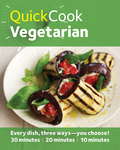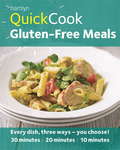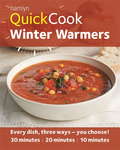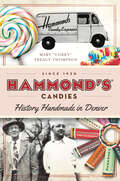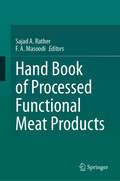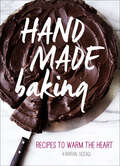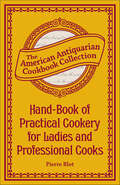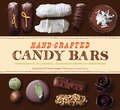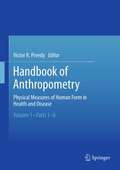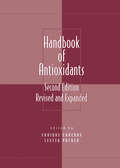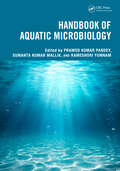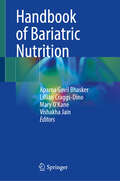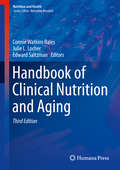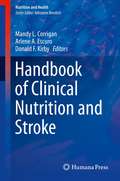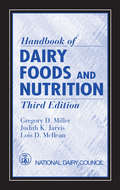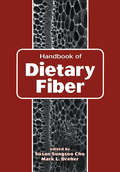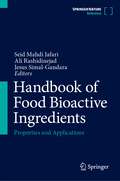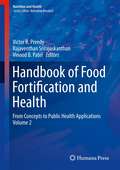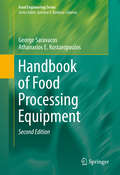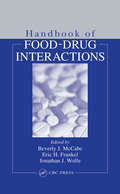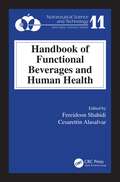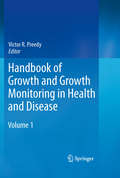- Table View
- List View
Hamlyn Quickcook Vegetarian
by Sunil VijayakarEasy vegetarian meals that can be made in just 30, 20 or 10 minutes, allowing busy cooks to choose from 360 great vegetarian recipes that they can fit into the limited time they have available. This fantastically flexible approach will help you create a variety of great dishes including breakfast and light bites, midweek meals, family favorites, food for friends, and delicious desserts.
Hamlyn Quickcook: Gluten-Free Meals
by HamlynGluten-free eating is a way of life for those who suffer from coeliac disease or gluten allergies or for those who simply prefer to cut wheat from their diet. With 360 delicious recipes, Hamlyn QuickCook: Gluten-Free Meals showcases how satisfying life can be when you go gluten-free.With recipes such as cocoa, orange & pecan flapjacks, chicken & cashew nut curry, tagliatelle with dolcelatte & walnut sauce, crispy cornbread and chocolate birthday cake, you can create healthy meals and special treats in the time that suits you - 30, 20 or as little as 10 minutes - without sacrificing any flavour.
Hamlyn Quickcook: Gluten-Free Meals
by Joy SkipperGluten-free eating is a way of life for those who suffer from coeliac disease or gluten allergies or for those who simply prefer to cut wheat from their diet. With 360 delicious recipes, Hamlyn QuickCook: Gluten-Free Meals showcases how satisfying life can be when you go gluten-free. With recipes such as Cocoa, Orange & Pecan Flapjacks, Chicken & Cashew Nut Curry, Tagliatelle with Dolcelatte & Walnut Sauce, Crispy Cornbread and Chocolate Birthday Cake, you can create healthy meals and special treats in the time that suits you - 30, 20 or as little as 10 minutes - without sacrificing any flavour.
Hamlyn Quickcook: Winter Warmers
by Jo McAuleySatisfying, fuss-free winter warmers are the perfect antidote to cold and rain. With this selection of 360 recipes a wide range of meals is at your fingertips. What's more, you can choose the recipe option to fit your busy schedule - prepare your food in just 30, 20 or 10 minutes. So banish the winter blues with deliciously comforting dishes, including Pork, Pepper & Chorizo Goulash, Tiger Prawn & Sweet Potato Curry, Cowboy Beef & Bean Casserole, Roasted Squash & Chickpea Tagine, Melting Chocolate & Date Fondants and Rhubarb & Clementine Crumbles.
Hamlyn Quickcook: Winter Warmers
by Jo McauleySatisfying, fuss-free winter warmers are the perfect antidote to cold and rain. With this selection of 360 recipes a wide range of meals is at your fingertips. What's more, you can choose the recipe option to fit your busy schedule - prepare your food in just 30, 20 or 10 minutes. So banish the winter blues with deliciously comforting dishes, including Pork, Pepper & Chorizo Goulash, Tiger Prawn & Sweet Potato Curry, Cowboy Beef & Bean Casserole, Roasted Squash & Chickpea Tagine, Melting Chocolate & Date Fondants and Rhubarb & Clementine Crumbles.
Hammond's Candies: History Handmade in Denver (American Palate Ser.)
by Mary "Corky" ThompsopnA history of the Denver-based candy company. In 1920, Carl T. Hammond founded his company with a commitment to quality. He single-handedly developed recipes, sold candy and handled everything else required to run the small operation. Nearly a century after that humble beginning, Hammond&’s Candies still clings to that original vision, creating prized confections by hand. The Mitchell Sweet, first introduced in the 1930s, is still a top seller, and visitors touring the factory can view the original machinery being used in production. Author Corky Thompson traces the history and growth of this family-owned company from 1920 until its sale at the end of the twentieth century and follows its transition under new ownership to the present time.
Hand Book of Processed Functional Meat Products
by F. A. Masoodi Sajad A. RatherFunctional food technology aims to boost consumer well-being by providing health benefits beyond that of fundamental nutrition. Meat and meat products have numerous disease-preventing and health-promoting benefits. However, the meat industry has faced many new challenges since the World Health Organization (WHO) studies suggesting that small increases in the risk of several cancers may be associated with high consumption of processed meat. In addition, consumers often associate meat with a negative health image. This negative image of meat is mainly due to fat content such as saturated fatty acids and cholesterol and process induced toxicants like N-nitroso compounds and polycyclic aromatic hydrocarbons (PAHs) and the alliance of these with chronic diseases. In this context, the functional food concept applied to meat processing has gained importance, especially by reduction/replacement of fat, sodium, nitrites, reduction of process induced toxicants and addition of beneficial components such as probiotics and bioactive compounds. Hand Book of Processed Functional Meat Products provides meat industry professionals with a step-by-step guide to post-mortem muscle chemistry, functional and cultured meat products-design and development, bioactive compounds, reduction of carcinogenic compounds, application of enzymes and nanotechnology, innovation in sensory assessment, authentication and marketing, 3D printing in the development of meat based products and regulatory and consumer challenges in functional meat products. This book differs from other publications on functional meat product processing in that it offers comprehensive coverage and in-depth discussion of the most recent scientific and technological applications in functional meat products. Many meat science and technology books available on the market describe meat chemistry, properties and basic science with only a rudimentary understanding of meat processing, functional meat products development and applications. Therefore, this work will be helpful for food industry professionals, policy makers, researchers, students, teachers and nutritionists and dieticians for a complete and up-to-date overview of functional meats processing and quality evaluation.
Hand Made Baking: Recipes to Warm the Heart
by Kamran SiddiqiThis cookbook from the passionate baker is “a pleasure to read . . . an unpretentious, cheery collection designed to ‘convert fear-filled nonbakers to experts.’” —Publishers WeeklyKamran Siddiqi, the self-taught baker and talented young blogger behind the Sophisticated Gourmet, delivers simple yet sophisticated recipes in his first book—a collection of more than seventy-five of his favorite homemade sweets. Designed to entice new bakers with his infectious passion for baking (and sugar in all its glorious forms), the pages are filled with classic favorites like Cream Scones and Chocolate Cake as well as lesser-known indulgences such as Chocolate–Brown Sugar Pavlova and Pistachio Polvorones. Kamran also believes in baking as a form of therapy, which comes through in such soothing balms as his Heartbreak Chocolate Truffle Cookies. With glorious photographs of each and every treat, Hand Made Baking is perfect for aspiring home cooks with an eye for the elevated taste and beauty of all things hand made.“Hand Made Baking feels lovely and personal, like you’re peering into the kitchen of a friend who’s invited you over for cake and coffee . . . draws you in and compels you to head straight for the kitchen.” —Food Network
Hand-Book of Practical Cookery for Ladies and Professional Cooks: Containing the Whole Science and Art of Preparing Human Food
by Pierre BlotPublished in 1867 in New York, Hand-Book of Practical Cookery was authored by the first American celebrity chef, Pierre Blot. An immigrant from France, Blot opened the first French cooking school in America and created this epicurean collection as an extension of his celebrated classes. In Hand-Book of Practical Cookery, Blot emphasizes the &“good things in life&” and wisely states in the preface, &“Food is the most important of our wants; we cannot exist without it.&” Basing recipes on precise and scientific measurements and including clear explanations of techniques and definitions, the Hand-Book of Practical Cookery, for Ladies and Professional Cooks includes recipes such as Beef Tongue with Sauces, Cabinet Pudding, Fried Celery, Duck with Garniture, Roasted Eel, and Candied Pears. After the book&’s release in 1867, the New York Times positively reviewed it and ended with the bold statement, &“The book ought to be in the hands of every housekeeper in the land&”—and its value is still evident to modern-day cooks. This edition of Hand-Book of Practical Cookery, for Ladies and Professional Cooks was reproduced by permission from the volume in the collection of the American Antiquarian Society, Worcester, Massachusetts. Founded in 1812 by Isaiah Thomas, a Revolutionary War patriot and successful printer and publisher, the society is a research library documenting the lives of Americans from the colonial era through 1876. The society collects, preserves, and makes available as complete a record as possible of the printed materials from the early American experience. The cookbook collection comprises approximately 1,100 volumes.
Hand-Book of Practical Cookery for Ladies and Professional Cooks: Containing the Whole Science and Art of Preparing Human Food
by Pierre BlotPublished in 1867 in New York, Hand-Book of Practical Cookery was authored by the first American celebrity chef, Pierre Blot. An immigrant from France, Blot opened the first French cooking school in America and created this epicurean collection as an extension of his celebrated classes. In Hand-Book of Practical Cookery, Blot emphasizes the &“good things in life&” and wisely states in the preface, &“Food is the most important of our wants; we cannot exist without it.&” Basing recipes on precise and scientific measurements and including clear explanations of techniques and definitions, the Hand-Book of Practical Cookery, for Ladies and Professional Cooks includes recipes such as Beef Tongue with Sauces, Cabinet Pudding, Fried Celery, Duck with Garniture, Roasted Eel, and Candied Pears. After the book&’s release in 1867, the New York Times positively reviewed it and ended with the bold statement, &“The book ought to be in the hands of every housekeeper in the land&”—and its value is still evident to modern-day cooks. This edition of Hand-Book of Practical Cookery, for Ladies and Professional Cooks was reproduced by permission from the volume in the collection of the American Antiquarian Society, Worcester, Massachusetts. Founded in 1812 by Isaiah Thomas, a Revolutionary War patriot and successful printer and publisher, the society is a research library documenting the lives of Americans from the colonial era through 1876. The society collects, preserves, and makes available as complete a record as possible of the printed materials from the early American experience. The cookbook collection comprises approximately 1,100 volumes.
Hand-Crafted Candy Bars: From-Scratch, All-Natural, Gloriously Grown-Up Confections
by Susan Heeger Susie Norris“Chocolate peanut butter cups and candy bars are transformed into elegant, sophisticated sweets using the finest chocolate and freshest ingredients.” —The San Diego Union-TribuneThe beloved candy bars of childhood have grown up, but there is no need to go to the French Laundry to get your fix. Candy bar devotees Susie Norris and Susan Heeger show how to reinvent candy bars as they should be—thick and layered with nougat, crisp with toffee, and coated with fine chocolate. Familiar candy-store bars and other nostalgic favorites are re-created using the freshest ingredients, right down to the peanut-laden caramel and chocolate-drenched cookie crunch. A mix-and-match flavor chart inspires anyone with a sweet tooth to dream up custom treats of their own, such as covering marshmallows with molten chocolate. From the basics of candy making to tips on dressing up these luscious indulgences as elegant desserts, Hand-Crafted Candy Bars evokes the sweet memory of youth with simple, scrumptious sophistication.“Recipes for everything from Molten Chocolate-Peanut Bars, a Snickers taste-alike, to Candied Mint and Citrus Bark. Those sugar-crisped mint leaves look particularly Halloweenish peeking from the surface.” —The Times Herald“Incorporates their love of candy, natural ingredients and other confections with terrific recipes for the home cook. You can even create your own signature candy bar (look for their suggestions in the mix-and-match flavor chart to get started).” —Dying for Chocolate“Their book is filled with recipes for making ‘grown-up confections’ from home using high-quality fresh ingredients. Far (but not too far) cries from the dollar bars at the corner store.” —Relish
Handbook of Anthropometry
by Victor R. PreedyAlthough its underlying concept is a relatively simple one--the measurement of the human body and its parts--anthropometry employs a myriad of methods and instruments, and is useful for a variety of purposes, from understanding the impact of disease on individuals to tracking changes in populations over time. The first interdisciplinary reference on the subject, the Handbook of Anthropometry brings this wide-ranging field together: basic theory and highly specialized topics in normal and abnormal anthropometry in terms of health, disease prevention, and intervention. Over 140 self-contained chapters cover up-to-date indices, the latest studies on computerized methods, shape-capturing systems, and bioelectrical impedance, data concerning single tissues and whole-body variables, and reports from different areas of the world. Chapters feature helpful charts and illustrations, cross-references to related chapters are included, and key points are presented in bullet form for ease of comprehension. Together, the Handbook's thirteen sections entail all major aspects of anthropometrical practice and research, including: Tools and techniques. Developmental stages, from fetus to elder. Genetic diseases, metabolic diseases, and cancer. Exercise and nutrition. Ethnic, cultural, and geographic populations. Special conditions and circumstances. The Handbook of Anthropometry is an invaluable addition to the reference libraries of a broad spectrum of health professionals, among them health scientists, physicians, physiologists, nutritionists, dieticians, nurses, public health researchers, epidemiologists, exercise physiologists, and physical therapists. It is also useful to college-level students and faculty in the health disciplines, as well as to policymakers and ergonomists.
Handbook of Antioxidants (Oxidative Stress and Disease)
by Enrique Cadenas Lester PackerContains new and expanded material on antioxidants in beverages and herbal products, nitric oxide and selenium, and the effect of vitamin C on cardiovascular disease and of lipoic acid on aging, hyperglycemia, and insulin resistance! Offering over 4200 contemporary references-2000 more than the previous edition-the Second Edition of the Handbook of Antioxidants is an up-to-the-minute source for nutritionists and dietitians, cell biologists and biochemists, cardiologists, oncologists, dermatologists, and medical students in these disciplines.
Handbook of Aquatic Microbiology
by Pramod Kumar Pandey, Sumanta Kumar Mallik, and Rameshori YumnamShort Blurb This handbook covers the different aspects of the aquatic environment, microbiology, and microbial applications. It highlights the role of microorganisms as pollution indicators and as bio-control agents. The book covers the impact of pollution on microorganisms, biofilms, cyanobacterial blooms, and the metagenomics approach to isolate microbes. Standard Blurb This comprehensive handbook covers the different aspects of the aquatic environment, microbiology, and microbial applications. The world’s aquatic environment is facing a serious threat due to inappropriate planning, implementation, and management. This book compiles effective strategies for managing the aquatic environment. It highlights the role of microorganisms as pollution indicators, in bioremediation, and as bio-control agents. The book also covers the impact of pollution on microorganisms, biofilms, cyanobacterial blooms, and the metagenomics approach to isolate microbes. This book is essential for students and researchers of microbiology, environmental sciences, and biotechnology Seasonal Blurb This comprehensive handbook covers the different aspects of the aquatic environment, microbiology, and microbial applications. The world’s aquatic environment is facing a serious threat due to inappropriate planning, implementation, and management. This book compiles effective strategies for managing the aquatic environment. It highlights the role of microorganisms as pollution indicators, in bioremediation, and as bio-control agents. The book also covers the impact of pollution on microorganisms, biofilms, cyanobacterial blooms, and the metagenomics approach to isolate microbes. This book is essential for students and researchers of Microbiology, Environmental Sciences, and Biotechnology. 1 Includes key themes like environmental DNA application, metagenomes, extremophiles, microbial population genetics and statistical aspects of aquatic microbiology 2 Discusses the beneficial microbes of the aquatic environment 3 Covers applications of microbes in bioremediation, as pollution indicators and as algicidal agents 4 Reviews freshwater biogeochemical cycles and sediment microbiology 5 Explores microbial communities of biofloc and microbiomes in aquaponics
Handbook of Bariatric Nutrition
by Aparna Govil Bhasker Lillian Craggs-Dino Vishakha Jain Mary O'KaneThe book covers all aspects of nutrition and well-being for patients who undergo metabolic and bariatric surgery. It also covers basic aspects of patho-physiology of obesity. With rising rates of obesity, metabolic and bariatric surgery is on the rise across the world. As metabolic and bariatric surgery leads to a major change in diet and has a potential to lead to nutritional deficiencies, there is an increasing need for experts in bariatric nutrition. The book explains the approach protocols and applications in the pre-surgery and post- surgery period. It covers the prevention and management of nutritional deficiencies in detail and contains relevant case scenarios to enhance the understanding of the readers. It explains specific nutritional approach to patients with special considerations who undergo metabolic and bariatric surgery, such as liver and kidney disease, organ transplant, pregnancy, adolescence, etc. The book provides easy-to-follow algorithms for nutrient supplementation and key points in each chapter. The book provides consolidated information on bariatric nutrition. It serves as a useful resource for practicing dietitians / nutritionists and students alike, surgeons, physicians and any other practitioners involved in metabolic and bariatric surgery.
Handbook of Clinical Nutrition and Aging
by Connie Watkins Bales Julie L. Locher Edward SaltzmanThis is the new and fully revised third edition of the well-received text that is the benchmark book in the field of nutrition and aging. The editors (specialists in geriatric nutrition, medical sociology, and clinical nutrition, respectively) and contributors (a panel of recognized academic nutritionists, geriatricians, clinicians, and other scientists) have added a number of new chapters and have thoroughly updated the widely acclaimed second edition. This third edition provides fresh perspectives and the latest scientific and clinical developments on the interaction of nutrition with age-associated disease and provides practical, evidence-based options to enhance this at-risk population's potential for optimal health and disease prevention. Chapters on a wide range of topics, such as the role of nutrition in physical and cognitive function, and coverage of an array of clinical conditions (obesity, diabetes, heart failure, cancer, kidney disease, osteoporosis), compliment chapters on food insecurity, anti-aging and nutritional supplements, making this third edition uniquely different from previous editions. Handbook of Clinical Nutrition and Aging, Third Edition, is a practical and comprehensive resource and an invaluable guide to nutritionists, physicians, nurses, social workers and others who provide health care for the ever-increasing aging population.
Handbook of Clinical Nutrition and Stroke
by Arlene A. Escuro Donald F. Kirby Mandy L. CorriganHandbook of Clinical Nutrition and Stroke is a comprehensive reference on nutrition for the multidisciplinary team caring for stroke patients. Targeting physicians, nurse practitioners, clinical dietitians, and advanced allied health and medical students, this volume provides an introduction on the different types of stroke, associated risk factors, and uniquely featured global perspectives on stroke. In addition to discussing stroke risk factors, the book expands upon treatment and management from the acute care setting through rehabilitation, captures the lifespan of patients affected by stroke, and discusses the progression of the nutrition care plan. Containing the most up-to-date, evidence based information currently available, Handbook of Clinical Nutrition and Stroke is a valuable resource for clinicians working with the stroke population.
Handbook of Dairy Foods and Nutrition
by Gregory D. Miller Judith K. Jarvis Lois D. McBeanHandbook of Dairy Foods and Nutrition, Third Edition examines the role of dairy products in diet and health, covering such areas as cardiovascular health, hypertension, cancer, bone, and oral health. This edition features a new chapter on dairy foods and weight management. Other chapters address lactose digestion and the contribution of dairy foods to health throughout the lifecycle. All chapters contain updated (or new) data, content, and references. With peer-reviewed chapters by nutrition and medical experts, this book remains the most subsidized reference on dairy and nutrition currently available.
Handbook of Dietary Fiber: An Applied Approach (Food Science And Technology Ser. #Vol. 25)
by Susan Sungsoo Cho; Mark L. DreherPresents the latest research on the analysis, metabolism, function, and physicochemical properties of fiber, fiber concentrates, and bioactive isolates--exploring the effect of fiber on chronic disease, cardiovascular health, cancer, and diabetes. Examines food applications and the efficacy and safety of psyllium, sugar beet fiber, pectin, alginate, gum arabic, and rice bran.
Handbook of Food Bioactive Ingredients: Properties and Applications
by Seid Mahdi Jafari Ali Rashidinejad Jesus Simal-GandaraBioactive ingredients, including both bioactive compounds and bioactive live organisms, are present in small amounts in natural sources such as fruits and vegetables. These ingredients have been continuously investigated during the last few decades and the epidemiological data suggest that their intake is associated with significant decreased risk of various disorders and chronic diseases owing to their anti-oxidant, anti-bacterial and anti-inflammatory qualities. Some of these natural ingredients such as catechins, curcumin, resveratrol, oleuropein, quercetin, rutin, hesperidin, sulforaphane, ellagic acid, and anthocyanins, have been studied as factors with possible direct or indirect effect on specific molecular pathways which are playing vital roles in the association with the pathophysiology of the chronic diseases such as cancer. In light of this, natural foods and food-derived products rich in bioactives have received recent growing attention. It has been reported that frequent consumption of fruits, vegetables, and their associated natural products have many health-promoting benefits that protect against degenerative illnesses including heart disease, arthritis, cancer, immune system decline, brain dysfunction, inflammation and cataracts. Functional foods and medicinal supplements containing encapsulated bioactive materials will be the future of new emerging products in the food and pharma industries. Such products present therapeutical and medicinal properties that can prevent and/or cure specific chronic diseases and disorders. Handbook Of Bioactive Ingredients provides a systematic overview of different food bioactive ingredients describing their chemistry, structure, functionality, safety/toxicity, oral delivery and their applications in functional foods. Detailed chapters will describe various bioactive ingredients including polyphenolic compounds such as phenolic acids, flavonoids and anthocyanins, carotenoids, sterols such as non-oxygenated carotenoids, xanthophylls and phytosterols, bioactive peptides such as marine bioactive peptides, animal bioactive peptides, plant bioactive peptides, microbial bioactive peptides, essential fatty acids like fish and marine oils and plant oils, live organisms like probiotics and yeasts, essential oils and oleoresins like monoterpens, sequiterpens and oleoresins, vitamins and minerals including liposoluble vitamins, hydrosoluble vitamins and trace minerals), and other bioactive compounds including prebiotics, oligosaccharides, dietary fibers and beta-glucan. This book is the first comprehensive collection of scientific evidence form published literature on natural bioactive ingredients.
Handbook of Food Fortification and Health: From Concepts to Public Health Applications Volume 1
by Victor R. Preedy Vinood B. Patel Rajaventhan SrirajaskanthanHandbook of Food Fortification and Health: From Concepts to Public Health Applications Volume 1 represents a multidisciplinary approach to food fortification. This book aims to disseminate important material pertaining to the fortification of foods from strategic initiatives to public health applications. Optimal nutritional intake is an essential component of health and wellbeing. Unfortunately situations arise on a local or national scale when nutrient supply or intake is deemed to be suboptimal. As a consequence, ill health occurs affecting individual organs or causing premature death. In terms of public health, malnutrition due to micronutrient deficiency can be quite profound imposing economic and social burdens on individuals and whole communities. This comprehensive text examines the broad spectrum of food fortification in all its manifestations. Coverage includes sections on definitions of fortifications, fortified foods, beverages and nutrients, fortifications with micronutrients, biofortification, impact on individuals, public health concepts and issues, and selective methods and food chemistry. Handbook of Food Fortification and Health: From Concepts to Public Health Applications Volume 1 is an indispensable text designed for nutritionists, dietitians, clinicians and health related professionals.
Handbook of Food Processing Equipment
by George Saravacos Athanasios E. KostaropoulosThis text covers the design of food processing equipment based on key unit operations, such as heating, cooling, and drying. In addition, mechanical processing operations such as separations, transport, storage, and packaging of food materials, as well as an introduction to food processes and food processing plants are discussed. Handbook of Food Processing Equipment is an essential reference for food engineers and food technologists working in the food process industries, as well as for designers of process plants. The book also serves as a basic reference for food process engineering students. The chapters cover engineering and economic issues for all important steps in food processing. This research is based on the physical properties of food, the analytical expressions of transport phenomena, and the description of typical equipment used in food processing. Illustrations that explain the structure and operation of industrial food processing equipment are presented. style="font-size: 13. 3333330154419px;">The materials of construction and fabrication of food processing equipment are covered here, as well as the selection of the appropriate equipment for various food processing operations. Mechanical processing equipment such as size reduction, size enlargement, homogenization, and mixing are discussed. Mechanical separations equipment such as filters, centrifuges, presses, and solids/air systems, plus equipment for industrial food processing such as heat transfer, evaporation, dehydration, refrigeration, freezing, thermal processing, and dehydration, are presented. Equipment for novel food processes such as high pressure processing, are discussed. The appendices include conversion of units, selected thermophysical properties, plant utilities, and an extensive list of manufacturers and suppliers of food equipment.
Handbook of Food-Drug Interactions
by Beverly J. McCabe Eric H. Frankel Jonathan J. WolfeWith contributions from the fields of pharmacy, dietetics, and medicine, Handbook of Food-Drug Interactions serves as an interdisciplinary guide to the prevention and correction of negative food-drug interactions. Rather than simply list potential food-drug interactions, this book provides explanations and gives specific recommendations based on th
Handbook of Functional Beverages and Human Health (Nutraceutical Science and Technology)
by Fereidoon Shahidi Cesarettin AlasalvarHandbook of Functional Beverages and Human Health provides potential applications and new developments in functional beverages, nutraceuticals, and health foods. In addition to serving as a reference manual, it summarizes the current state of knowledge in key research areas and contains novel ideas for future research and development. Additionally,
Handbook of Growth and Growth Monitoring in Health and Disease
by Victor R. PreedyGrowth is one of the human body's most intricate processes: each body part or region has its own unique growth patterns. Yet at the individual and population levels, growth patterns are sensitive to adverse conditions, genetic predispositions, and environmental changes. And despite the body's capacity to compensate for these developmental setbacks, the effects may be far-reaching, even life-long. The Handbook of Growth and Growth Monitoring in Health and Disease brings this significant and complex field together in one comprehensive volume: impact of adverse variables on growth patterns; issues at different stages of prenatal development, childhood, and adolescence; aspects of catch-up growth, endocrine regulation, and sexual maturation; screening and assessment methods; and international perspectives. Tables and diagrams, applications to other areas of health and disease, and summary points help make the information easier to retain. Together, these 140 self-contained chapters in 15 sections [ok?] cover every area of human growth, including: Intrauterine growth retardation. Postnatal growth in normal and abnormal situations. Cells and growth of tissues. Sensory growth and development. Effects of disease on growth. Methods and standards for assessment of growth, and more. The Handbook of Growth and Growth Monitoring in Health and Disease is an invaluable addition to the reference libraries of a wide range of health professionals, among them health scientists, physicians, physiologists, nutritionists, dieticians, nurses, public health researchers, epidemiologists, exercise physiologists, and physical therapists. It is also useful to college-level students and faculty in the health disciplines, and to policymakers and health economists.
